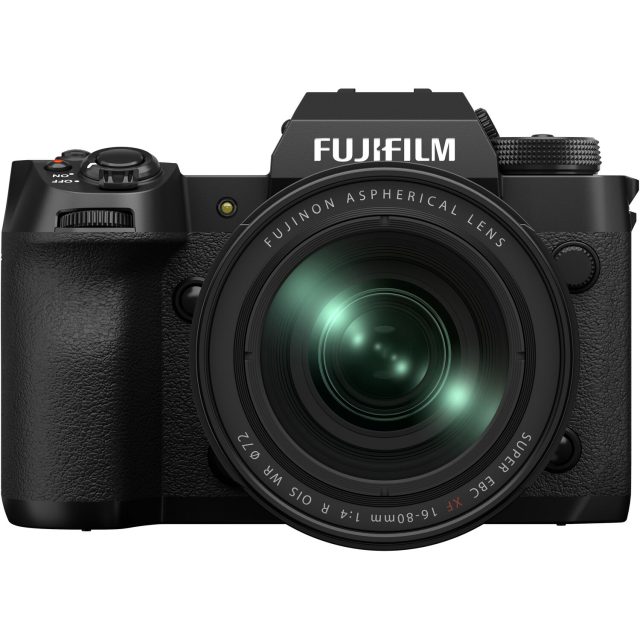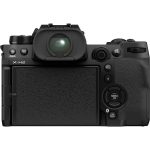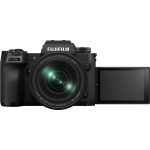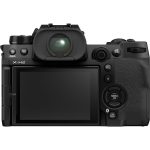Announced
Production status
System
Fujifilm X system cameras
- Fujifilm X-A1
- Fujifilm X-A10
- Fujifilm X-A2
- Fujifilm X-A20
- Fujifilm X-A3
- Fujifilm X-A5
- Fujifilm X-A7
- Fujifilm X-E1
- Fujifilm X-E2
- Fujifilm X-E2S
- Fujifilm X-E3
- Fujifilm X-E4
- Fujifilm X-H1
- Fujifilm X-H2
- Fujifilm X-H2S
- Fujifilm X-M1
- Fujifilm X-Pro1
- Fujifilm X-Pro2
- Fujifilm X-Pro2 Graphite Edition
- Fujifilm X-Pro3
- Fujifilm X-S10
- Fujifilm X-S20
- Fujifilm X-T1
- Fujifilm X-T1 Graphite Silver Edition
- Fujifilm X-T10
- Fujifilm X-T100
- Fujifilm X-T2
- Fujifilm X-T2 Graphite Silver Edition
- Fujifilm X-T20
- Fujifilm X-T200
- Fujifilm X-T3
- Fujifilm X-T30
- Fujifilm X-T30 II
- Fujifilm X-T4
- Fujifilm X-T5
- Fujifilm X-T50
Fujifilm X-H2
APS-C AF digital mirrorless camera
Specification
| Format: | |
| APS-C | |
Imaging sensor: | 23.5 × 15.6mm X-Trans CMOS 5 HS sensor |
Resolution: | 7728 × 5152 - 40 MP |
Crop factor: | 1.53x |
Sensor-shift image stabilization: | Yes |
| Fujifilm X [17.7mm] | |
| Shutter: | |
Type: | Focal-plane |
Model: | Electronically controlled |
Speeds: | 900 - 1/180000 + B |
| Exposure: | |
Exposure metering: | Through-the-lens (TTL), open-aperture |
Exposure modes: | Programmed Auto |
| Aperture-priority Auto | |
| Shutter-priority Auto | |
| Manual | |
| Physical characteristics: | |
Weight: | 579g |
Dimensions: | 136.3x92.9x84.6mm |
Manufacturer description
TOKYO, September 9, 2022 – FUJIFILM Corporation (President and CEO, Representative Director: Teiichi Goto) is pleased to announce the launch of the mirrorless digital camera “FUJIFILM X-H2” (X-H2) in late September. It is the latest addition to the lineup of the X Series of compact and lightweight cameras renowned for their outstanding image quality, delivered by Fujifilm’s proprietary color reproduction technology.
The X-H2 features the new back-illuminated 40.2MP “X-Trans™ CMOS 5 HR”*1 sensor and the high-speed “X-Processor 5.” This is a new flagship model boasting the highest image quality in the history of the X Series, capable of capturing high-resolution stills and high-definition 8K/30P video. It extends photographic and videographic coverage of the X Series further to cater to diverse user needs.
The X-H2 equips with the 40.2MP APS-C sensor, capable of producing stills and videos with outstanding high resolution, and offers the shutter speed as fast as 1/180000 sec and ISO125 as standard sensitivity, thus broadening the coverage of photographic categories. This is also the first X Series camera that provides the Pixel Shift Multi-Shot function to enable 4x higher image resolution and accurate color reproduction, as well as the Smooth Skin Effect to automatically re-touch skin which enables to produce 160MP images and portraits with smoothed skin. The use of AI-based Auto White Balance function supports to create high-quality images with ease.
The X-H2 is the first APS-C sensor camera*2 to support the recording of high-resolution 8K/30P video. It is packed with other features to facilitate high-quality video production in a variety of conditions, including the subject-detection AF to detect animals, birds, etc. with AI, as well as the five-axis in-body image stabilization (IBIS) mechanism that offers up to 7.0-stops*3 of image stabilization.
In July this year, Fujifilm introduced the FUJIFILM X-H2S (X-H2S), an X-Series flagship suited to photograph a moving subject with the ability to take up to 40 frames per second in blackout-free continuous-shooting*4. Developing a double-flagship structure by adding the X-H2 to the X-H2S, the company ensures to cater to all the shooting needs of professional photographers and videographers.
*1 X-Trans is a trademark or registered trademark of FUJIFILM Corporation.
*2 As of September 9, 2022 according to Fujifilm.
*3 When mounted with the FUJINON Lens XF35mmF1.4 R.
*4 High-speed continuous shooting free from the viewfinder blacking out, which prevents users from seeing the subject; This is only available when using the electronic shutter.
1. Product features
(1) Featuring the new X-Trans™ CMOS 5 HR sensor to produce the highest image quality in the history of the X Series
- The X-H2 is equipped with the all-new back-illuminated 40.2MP “X-Trans™ CMOS 5 HR” sensor and updated image-processing algorithm to enhance image resolution without compromising the S/N level, producing the highest image quality in the history of the X series. The new sensor has an improved pixel structure to efficiently bring in a greater amount of light. This means ISO125 is available as a standard sensitivity. This is particularly beneficial during day-time outdoor shooting or to take advantage of fast lenses to produce bokeh.
- The use of the new sensor and resulting ability to control exposure time at a greater precision have improved the fastest shutter speed for the electronic shutter by approximately 2.5 stops from the previous model’s*5 1/32000 sec to 1/180000 sec. This allows users to leave the aperture wide open in glary conditions such as a sunny beach or a ski slope, or to capture a split-second motion in studio and other locations.
- This is the first X Series camera featuring the Pixel Shift Multi-Shot function, which quadruples image resolution and produces accurate color reproduction. The camera uses the IBIS mechanism to shift the image sensor at high precision to carry out automatic shooting of 20 frames in a single click of the shutter. The dedicated software “Pixel Shift Combiner” processes the captured frames to generate an image containing some 160 million pixels, which is perfect for commercial photography and digital archiving of cultural assets.
- The Smooth Skin Effect which automatically smooths the skin tone is also featured for the first time in the X Series camera. It reduces post-processing workload required in portrait photography, etc., so that images can be finished at an advanced level of perfection much quicker than ever before.
- Using the Deep Learning technology, Fujifilm has boosted the camera’s performance in Auto White Balance. The AI technology accurately identifies warm light-bulb color cast to adjust white balance for improved accuracy.
- The X-H2 comes with 19 Film Simulation modes, including “Nostalgic Neg.,” characterized by high saturation and soft tonality. Users can use Film Simulation presets, designed for various subject types and scenes, as if they are choosing photographic films.
- The camera supports the HEIF format, which enables recording images with a rich 10-bit color depth despite being 70% of the size of an equivalent JPEG file. It can store image data more efficiently while retaining advanced quality.
*5 Mirrorless digital camera “FUJIFILM X-T4.”
(2) Excellent video performance that caters to professional video production needs
- This is the first X Series camera to support the recording of 8K/30P video in 4:2:2 10-bit. Featuring the heat-dissipating structure same as that of the X-H2S, this model iseis capable of recording 8K/30P video for approximately 160 minutes*6. It also supports the 4K HQ mode, i.e. 8K over-sampling to produce high-quality 4K video, making the maximum advantage of the high-resolution sensor to deliver images in superior image resolution.
- X-H2 supports three Apple ProRes*7 codecs; ProRes 422 HQ, ProRes 422, and ProRes 422 LT. When recording ProRes, X-H2 also supports proxy recording such as ProRes 422 Proxy*8. This reduces 8K video’s editing workload and streamlines the overall workflow from filming to post-production.
- The camera features the new digital zooming function*9 for use during video recording. Even when mounted with a prime lens, the camera can achieve up to 2x digital zoom without compromising image resolution. When the XF18-120mmF4 LM PZ WR, which supports power zoom, is mounted, the camera can deliver smooth zooming as it can seamlessly transition from optical zoom to digital zoom.
- Combined with a compatible HDMI recording device, ATMOS NINJA V+*10 or Blackmagic Design’s Video Assist 12G*11, 12-bit RAW video output from X-H2 can be recorded as Apple ProRes RAW or Blackmagic RAW at resolutions and frame rates of up to 8K and 30 frames per second.
- The X-H2 features F-Log2 for recording video in the expanded 13+ stop dynamic range for enriched tonality and adds freedom in post-production creativity.
*6 At the time of a cold start in the operating environment at 25℃, with the Auto Power Off Temperature set for “High,” H.265 4:2:0, Bitrate setting at 200Mbps, the vertical battery grip “VG-XH” attached and three batteries used. The recording time depends on the remaining level of battery charge and the type / capacity of memory card used. Note that the camera may automatically stop recording video when the body temperature rises beyond the threshold.
*7 Apple ProRes is a trademark of Apple Inc., registered in the United States and other countries.
*8 Not available in 8K/30P and 8K/25P.
*9 Available in the 4K HQ, 4K DCI HQ and FHD modes.
*10 An integrated monitor and recorder by ATOMOS.
*11 An integrated monitor and recorder by Blackmagic Design.
(3) Evolved AF performance that captures details accurately
- The X-H2 is equipped with subject-detection AF, developed with Deep Learning technology. It uses AI to detect a variety of subjects including animals, birds, cars, motorcycles, bicycles, airplanes and trains. The system automatically tracks a subject while maintaining focus, so that users can concentrate on shutter opportunities and framing.
- The new high-resolution sensor has an increased number of phase detection pixels, resulting in an improved ability to attain AF-S*12 focus on a subject with high-frequency subject such as animal fur and fine leaves. Users can easily autofocus accurately in situations where AF-S is typically used, such as landscape and portrait photography. The new camera also features an AF prediction algorithm, originally developed for the X-H2S, for stable focusing even in the AF-C*13 mode.
- The magnification for the Focus Check function, in which the area to be focused can be enlarged in the AF/MF mode, has been doubled the previous model’s*5 up to 12 times. A focus meter has been newly added to assist manual focusing during video recording to enable focus adjustment with greater precision.
- The video AF algorithm has been optimized to substantially improve AF accuracy during video recording. This gives users peace of mind when recording 8K video, which requires focusing of advanced accuracy.
*12 AF-S autofocuses on a subject when the shutter button is half-pressed, and keeps it locked once the focus is attained.
*13 AF-C continuously maintains focus on a subject within the focus area while the shutter button is half-pressed.
(4) Hardware that promises ease of operation to support users’ content creation
- The X-H2 features a five-axis IBIS mechanism that offers up to 7.0-stops of image stabilization. Users can shoot hand-held even in low light conditions such as nightscape photography.
- The X-H2 is equipped with a high-magnification and high-definition 5.76-million-dot EVF with 0.8x magnification. It suppresses parallax and distortion which typically occurs when an eye position becomes displaced while using the viewfinder for stellar visibility. It boasts smooth refresh frame rate of approx. 120fps to accurately identify a subject’s fast movements.
- The X-H2 shares the same design features as the X-H2S such as an LCD display on the top panel that allows users to check settings at any time, a highly-robust body that withstands heavy professional use, the shutter button’s feel when it is half-pressed, adjustment to the feel of the AF ON button when it is pressed.
- The camera has a standalone video-recording button and features a 1.62-million-dot vari-angle rear LCD monitor, which can be positioned in a range of angles to enable filming as intended.
- The camera features dual memory card slots supporting CFexpress™ Type B*14 and SD cards. Use CFexpress™ Type B memory card, which has high-speed data writing capability, to draw out the full potential of X-H2’s video performance.*15
- The X-H2 can be combined with the file transmitter “FT-XH” to enable wired and wireless LAN tethered video recording.*16 Up to four cameras*17 can be connected simultaneously to enable the following operations from a computer browser:
- Checking and operating each camera’s settings
- Simultaneously recording video on multiple cameras
- Saving / loading / copying camera settings*18
*14 CFexpress is a trademark or registered trademark of the CompactFlash Association.
*15 See the Fujifilm website for a list of memory cards that have been verified to work with this camera.
*16 To use the remote recording function on the X-H2S, update the camera to the latest firmware.
*17 Available with the X-H2 and X-H2S.
*18 Each camera’s shooting settings can be saved on devices such as a computer and a tablet device. Shooting settings saved in such a device can be loaded or copied to a camera.
2. Optional accessories
(1) Vertical battery grip “VG-XH” (for X-H2 and X-H2S) (Available)
- The vertical battery grip can load two of the high-capacity battery “NP-W235.” It is also dust and moisture resistant and operates at temperatures as low as -10℃ for advanced practical applications.
- The grip features various buttons on convenient locations for vertical shooting to provide the same level of operability with horizontal shooting.
(2) File transmitter “FT-XH” (for X-H2 and X-H2S) (Due to be released in the middle of October)
- This file transmitter features wired LAN connectivity and high-speed wireless communications capability, essential for in-studio tethered shooting or sports / media shooting. It can be also used as a vertical grip and fits two of the high-capacity battery “NP-W235.”
- It can be combined with the X-H2 / X-H2S to support the following:
- FTP transfer by wired LAN / wireless LAN / Smartphone tethering
- Tethered shooting by wired LAN / wireless LAN
- Remote Rec function by wired LAN / wireless LAN
(3) Cooling fan “FAN-001” (for X-H2 and X-H2S) (Available)
- This cooling fan can be fitted to the rear panel of the camera body without a cable, supporting long hour shooting and video recording in a high temperature condition. The power can be supplied to the fan from the camera body.
(4) Cover kit “CVR-XH (for the X-H2 and X-H2S) (Available)
- Items contained in the cover kit for protecting various terminals on the camera
- 1 x Sync terminal cover
- 1 x Hot shoe cover
- 1 x File transmitter / vertical battery grip terminal cover
- 1 x Cooling fan terminal cover
- 1 x Memory card slot cover




